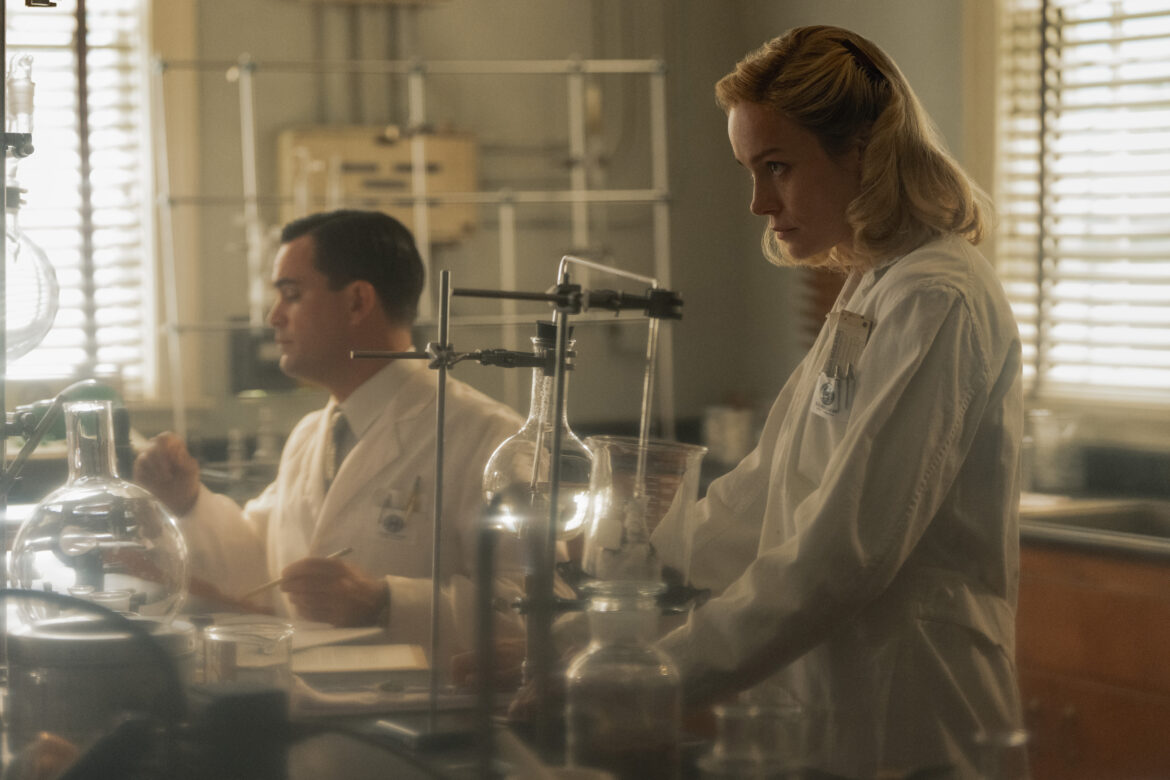By Kirsten Coachman
“In science, you endeavor to control every variable of your experiment. The temperature in your lab, the number of contaminants, the correct calibration for each piece of equipment,” a solemn Elizabeth Zott (played by Oscar winner Brie Larson, “Room”) tells her “Supper at Six” audience. “Sometimes you can’t count on a formula. Sometimes, you can’t control each variable. Sometimes, many times, things just turn out messy.”
Last month, the first two episodes of “Lessons in Chemistry,” a new limited series, premiered on Apple TV+. The series, based on the bestselling novel of the same name by Bonnie Garmus, follows Elizabeth Zott and the patriarchal challenges she must continually confront as a young chemist in the 1950s. Created by Lee Eisenberg (“The Office”), “Lessons in Chemistry” stars Larson (who also serves as executive producer), Aja Naomi King (“How to Get Away with Murder”), Stephanie Koenig (“The Flight Attendant”), and Lewis Pullman (“Top Gun: Maverick”).
At the helm of episode one, “Little Miss Hastings,” and episode two, “Her and Him,” is director Sarah Adina Smith, who also served as executive producer for the episodes. She made her feature directorial debut in 2014 with “The Midnight Swim.” In 2016, she worked with now Oscar winner Rami Malek on “Buster’s Mal Heart.” Her television credits include HBO’s “Room 104,” Amazon’s “Hanna,” and Hulu’s “Looking for Alaska” and “The Drop.”
The first two episodes of “Lessons in Chemistry” introduce audiences to the world of Elizabeth Zott (Larson), a young chemist working as a lab technician at Hastings University. Elizabeth’s adept flair for cooking—be prepared to want to try your hand at making lasagna—unintentionally assists in adding an unexpected variable to her life in the form of Dr. Calvin Evans (Pullman).
Art U News recently had the opportunity to sit down with Smith and “Lessons in Chemistry” food consultant and chef Courtney McBroom to chat about what went into making the first two episodes, from collaboration to Larson setting the tone on set, honoring the book, and some key advice for Academy students.
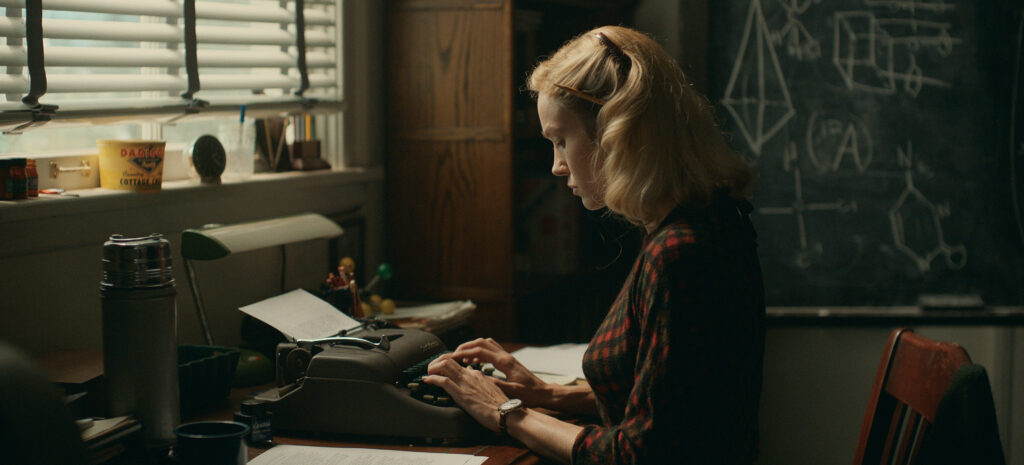
Sarah, you get to introduce Elizabeth and all her sort of different facets. We learn all these different aspects about her as far as what she goes through working with the guys at Hastings, that she’s an absolute nerd about cooking, and that she’s experienced a trauma that has set boundaries for herself. What do you like about being able to kind of establish who this character is in the first episodes and introduce her to the audience that may not have read the book?
Sarah Adina Smith (SAS): It’s my greatest joy as a director to get to work really closely with actors to help them find their character, particularly when setting up a series like this. And so it was just something that Brie and I talked a lot about, and every day continued that conversation, and every day it was about digging further and challenging each other to get to the truth of something.
And what I love about working with Brie is she is an adventurous spirit with an inquiring mind. And so she’s always pushing for the deeper truth of something. And I always try to do the same. It’s really a director’s dream when you have an actor who does that, too. The whole cast was such a joy. Working with Aja, working with Lewis, and finding those, not just one-on-one, but those relationships, was also really important to me. I like to say as a director, when I’m in rehearsals with actors, I want those relationships to feel really real and earned. So I’ll say to them, I want you guys to have your own secrets together that I don’t know as a director. So when you feel like you have a secret world that I’m spying on, I think that can be…
Courtney McBroom (CM): That’s brilliant.
SAS: …sometimes really fun.
Oh, I love that. Courtney, as food consultant—I watched an interview that somebody had done with you, and they were just like, “That’s the best title.” And I fully agree.
CM: [Laughs.] I second that.
SAS: I have to say, though, I wish it was like food queen or priestess of culinary arts.
What all goes into your role? How layered—pardon the pun—is it?
CM: It’s like lasagna. It always goes back to lasagna. I started out working with the directors, producers, the writers, with Brie, who’s also executive producer on the show, and figuring out how we wanted the food to look, how we wanted it to pop off the screen. We knew for sure that we wanted everyone to be really hungry when they watched the show. That’s what success meant to me.
We decided that Elizabeth Zott is a woman of the ’50s. She’s a woman of her time. She’s also clearly a woman ahead of her time too. And we wanted that to be represented in the food as well. We knew that food was a very important part of the storytelling of the show, in general. So, brainstorming, figuring all that out, and I would take that and then go back to the kitchen where I had an amazing super talented team of food stylists working with me to create the food that you then see in the show.
And then the other thing that we did too is we actually wrote the recipes, and we’re releasing the recipes along with it. So you can go to lessonsinchemistryrecipes.com, and I’m encouraging everyone to throw watch parties and make the food from the show and then watch [the episodes].
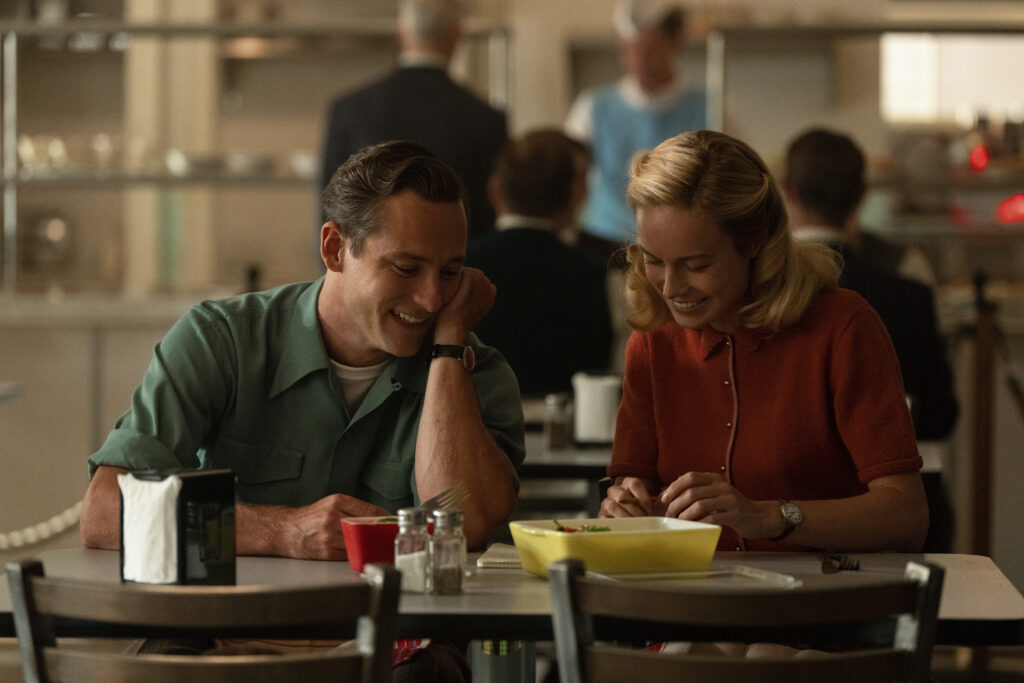
I will say I’ve never made a lasagna, but now I’m fully tempted to.
CM: Oh, you should. I will not lie; it’s a bit time-consuming, but it’s easy to do. It just takes some time, and it’s so, so worth it.
SAS: I will say that a lot of times as a director, when you’re working on set, an actor—because you have to do a lot of takes—will take a bite of food and then spit it out so they don’t get too full, honestly. But no one wanted to spit out Courtney’s food. [Laughs.] It’s truly delicious. And the crew, everyone, would get really hungry for lunch, and their mouths would be watering.
CM: Yeah. I sent so much food home with the crew, too.
With directing the first two episodes, is it a challenge or daunting at all to kick off a new series?
SAS: I am always up for a challenge, so I like to throw caution to the wind and really just go for it. And I feel that it’s my role as a pilot director to not just think about directing my two episodes but really to think about the full spectrum of building the world of this show and setting everybody else up for success. And I try to look at it that way.
Your episodes set up this love story between Elizabeth and Calvin. Was it just as sort of warm fuzzy feelings on set as it comes across the screen?
Yes, in the sense that [Brie and Lewis] are two consummate professional actors who are at the top of their game in terms of their craft, and the trust was unbelievable from the beginning. And, of course, trust has to be earned, but I felt like it was my job to help facilitate that as well. And the three of us, I think, very quickly found a shared language, which was about allowing for happy accidents to happen on camera. You can’t ironically, if you want to capture the chemistry of a love story, you can’t force it. You can’t force surprise to happen, but you can create really, for lack of a better word, kind of cozy conditions, even amidst the chaos of a set where you’ve got 200 people running around, if as a director and as actors, if you can kind of carve out your own little space within all of that chaos, then it allows for some magic to happen on screen.
Part of that magic that we see is at lunch as Elizabeth is unveiling these different lunches, which are maybe the most Instagramable meals that I have seen on screen. What all went into placement—every time she removed a lid, I was like, oh my God.
CM: So, that was my first day on set [laughs], and we shot in those scenes.
SAS: It’s so funny that it was your first day on set.
CM: Like straight into the fire. I mean, that’s how I learn, too. It’s like, “All right, let’s do this. Let’s go.”
SAS: I have to say a memory flashed back to me; I was so impressed with you on every level, but I remember the moment you cut those beautiful, fresh figs, and they were so colorful and gorgeous. I was like, “Oh, thank goodness we have Courtney here.”
CM: Well, and we got really lucky that those figs just happened to be in the grocery store that day. So, the figs that we used were the ones that they’re pink inside and green on the outside. They’re gorgeous. But there are other figs, you know, the typical brown ones, you cut it, and it’s like brown on brown, which is also beautiful. But I was really hoping that they had those. I was scouring all of L.A. for these figs, and I bought the grocery store out of all of ’em. I got the last four tubs. It’s all about the figs.
Like, thinking about the colors, I want the colors to pop. And with the style of the show, it’s not as like ’50s poppy. It’s a little bit muted, but you can still see the colors and the beauty of the food.
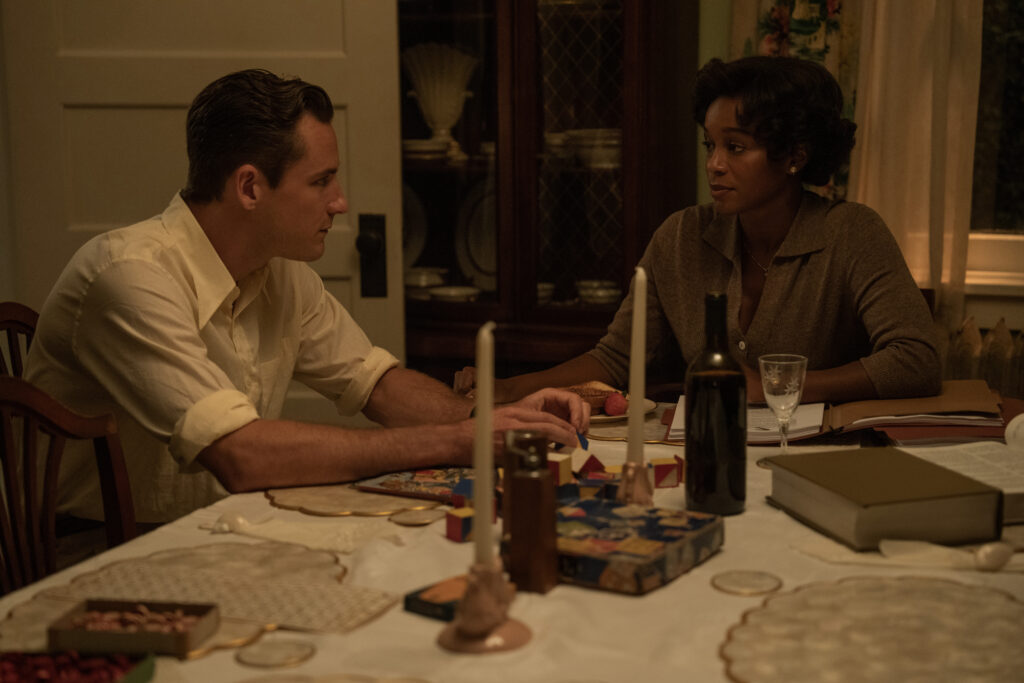
As far as collaboration, especially between the two of you, but also both of you with the cast, what did that look like?
SAS: TV is an extremely collaborative medium, so it’s collaboration on every level. Um, and when it comes to the food collaboration with the cast, I loved it because we were so lucky that Brie actually cooks herself a lot. So she has a lot of skills, but then we had Courtney, who was also her hand double [laughs] with the knife skills.
CM: I was the hand double. All the close-ups are me.
SAS: So that was such just a great tag team. And it was fun. I felt like I had an Elizabeth Zott and her cooking double [laughs] to work with.
CM: It was so fun.
SAS: Yeah. It was just really fun.
And Courtney, you are long-time friends with Brie, so how was that getting to hang together in a professional setting?
CM: It was so cool for me to actually be able to see her work. ’Cause I’d never like been on set with her before. I obviously knew how incredibly talented she was, but something about seeing her in action, either after the director says action or just an action, while she’s learning her lines and getting ready, and she had such positive energy. She had this thing where she would bring games onto set, and in the downtime, everyone would play games and make it as fun as possible. But then, when it was time to work, it was time to work. And it was so inspiring to see her do that, and I was just awed by her.
SAS: I’m so glad you brought that up because I think that’s something that doesn’t get talked about enough actually with lead actors in series and films; they really help set the tone for the entire cast and crew. And, you know, if you have a lead actor who makes coming to work difficult in a way, it just makes such a difference in everyone’s experience. Whereas Brie, I think, is just as committed to the process and making the process joyful for everybody as she is to her craft. And I say that almost like on a spiritual level, I feel like she really believes that every day and everyone’s experience should also matter. And that kind of respect is invaluable.
Was there anything from the book, whether it was your episodes or any point in the series, that you really wanted to feel was being honored, whether it was a certain scene or a specific meal?
SAS: There’s so much about the book that we wanted to honor. And we also knew, and thank goodness Bonnie trusted us to do this because we knew that there were also inevitably going to need to be changes to translate the book to screen. But I think, at the end of the day, the thing that we wanted to honor most, I suppose, is this central idea of the book that, for a character who has had to, as you mentioned earlier, very insightfully, be so controlled almost in order to protect herself and who is a scientist who sort of likes to control all the variables and to be as predictable as possible that we watched Elizabeth learn to have those take those walls down and to open herself up to surprise again. I think when I first met with Lee Eisenberg, he zeroed in on that theme. And for me, that was the most important thing to honor with every decision that I made.
CM: You did a really good job!
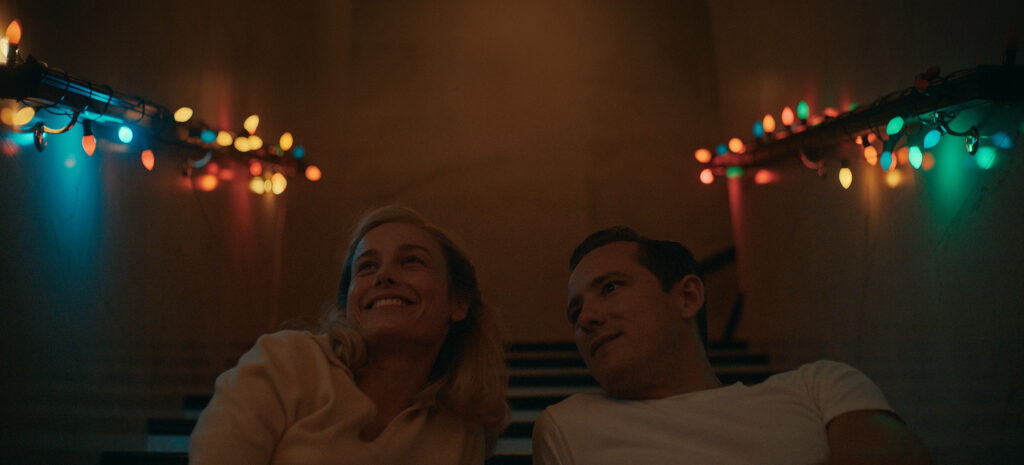
And was there a certain meal for you that you wanted to make sure had an extra shine on screen?
CM: I think the chicken pot pie—[and] obviously lasagna. I feel like I’ve talked so much about lasagna [laughs]. I think the chicken pot pie scene was a really important scene because that’s the catalyst that gets her onto the show. Also, one of my favorite food parts, I can’t remember right now which episode it is, but it’s not come out yet. There’s this little school lunchbox scene, and it tells a story. And I don’t wanna do too many spoilers, but I think they take the lid off of that little kid’s school lunch, and Elizabeth is the one that makes the lunch, and you can see how much love goes [into it]. And we spent a lot of time on that lunch. I was like, “Okay, the crust has to be cut off the bread, and the sandwich has to be cut diagonal because that’s the most important part.” And then there’s like little cute vegetables and the really cute little brownie, and it just makes my eyes water every time I see it ’cause you can see how much love and thought went into that lunch.
Chemistry is defined in different ways throughout the show—did you have a favorite chemistry aspect of the show?
SAS: I thought it was really important that we portray to the best of our abilities what the day-to-day life of an experimental biochemist might look like. The truth of the matter is a lot of the experiments they were doing were with clear liquids that basically just looked like water. And it’s not the most exciting; it’s a lot of repetition. And it’s a lot of, maybe, ooh, the water’s bubbling [laughs].
I felt so lucky to get to work with like Teagan Wall and some of the really top-of-the-line science consultants to help us get that right and bring some authenticity to the show. The moment that comes to mind when you asked that question was just the moment in the Christmas scene in episode two when Calvin and Elizabeth are so excited about their work that for them celebrating Christmas is to continue working. And you just see it’s just this little small moment where just the contraption that beeps and it lets them know a reaction happened that they were looking for. And it’s just like the giant victory that happens from that one little beep, in a way, was actually just so fun to portray.
The second episode ends quite shockingly. Without getting too much into spoilers for those who haven’t seen it yet, what is it like to work and build up a storyline only to know in the back of your mind that it’s going to come crashing down very suddenly?
SAS: As we were getting closer and closer to having to film that moment, I just remember Brie and I like needing to hug each other [laughs], like, sometimes during the day. And yeah, it was hard because I think we were all very much embedded in the story as we were making it, and it felt like we were kind of all falling in love as they were falling in love. We’re weirdo artist people, so we’re sensitive, and even though we know it’s make-believe, we take it seriously.
CM: It’s still really sad.
SAS: Yeah. It’s really sad and really hard.
At the Academy of Art, we have our Schools of Entertainment, which covers film, TV, and writing. Is there maybe a piece of advice or something that you would tell students to keep in mind as they work on their first film projects?
SAS: If I could go back and tell myself something, I would say don’t be in too much of a rush to get to the next level. Be where you are now because you have a gift in those early days of not knowing what you don’t know yet; there’s a wonderful fearlessness and even naivete that actually works to your benefit. And I think look around you and bond with your peers who are in the same place again, rather than necessarily asking the question of how can I get to the next level or break in here, break there, join arms with your peers, make something together and really relish that moment. ’Cause that’s gonna end up being the creative engine that powers you for the rest of your career.
CM: Because rising tides raise all ships.
SAS: It’s very true.
“Lessons in Chemistry” is available to stream on Apple TV+. New episodes will be added every Friday through November 24. This Q&A has been edited for length and clarity.
